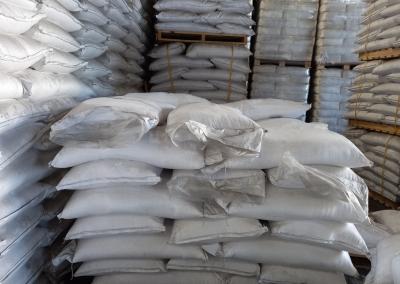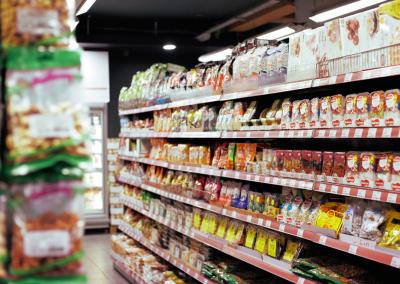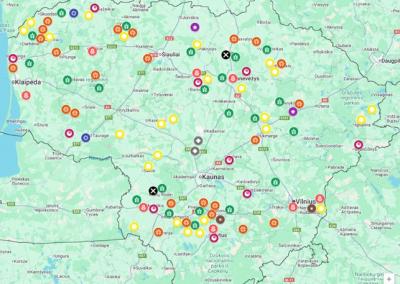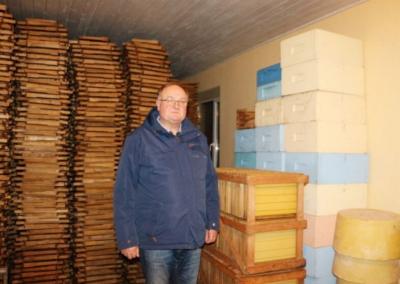Lithuanian timber exports fell by 8%.
Trade in wood and its products (including paper and its products, furniture) declined at a slower pace than total foreign trade in the first half of 2024. The value of exports of wood and wood products fell by 5.2% to €2.06 billion in the first half of the year. The share of wood and wood products in total exports increased from 10.7% to 11.0% over the year. This decline in wood and wood products exports is largely due to a 5% decrease in furniture exports. The decline in the value of roundwood exports was faster than that of furniture exports – 15%. The value of exports of prefabricated wooden buildings fell by 12%, while the value of exports of paper and paper products fell by 11%.
The value of wood and wood products sold on the German market amounted to €248 million, 3.7% lower than in 2023. Exports to Sweden fell by 11.3% to €183 million. Exports to the United Kingdom decreased by 4.4% to EUR 174 million and to Norway by 13% to EUR 133 million. Exports to Poland increased by 2.5% to €157 million and to Denmark by 5% to €135 million.
Imports of meat and meat products fell by 4.2% to €830 million in the first half of 2024. The value of imported wood chips, pellets and briquettes halved compared to the same period in 2023. The value of wood veneer fell by 21% and plywood by 16%. Imports of paper and paper products decreased by a relatively small – 4%. Imports of these products in the first half of 2024 amounted to €263 million.
The main imports of meat and meat products were from Poland – for €240 million. Imports from Latvia amounted to €119 million. Imports from Poland decreased by 0.8% and from Latvia by 9.4%. Imports from Germany fell by 4.5% to €71 million. Imports from Sweden amounted to €56 million, 13% lower than in 2023. Imports from Ukraine decreased by 8.9% to €52 million.
The value of timber and timber products exported was two and a half times higher than the value of imported goods, and the positive trade balance fell from €1.3 billion to €1.2 billion over the year.
Whole wood
Exports. In the first half of 2024, exports of roundwood (excluding firewood) amounted to 848,000 m³ or 4% more than a year earlier. Exports increased from 385 thousand m³ in the first quarter to 463 thousand m³ in the second. Softwood exports increased by 19% compared to 2023 to 636 thousand m³, while hardwood exports decreased by 25% to 212 thousand m³.
During the half-year, 424 thousand m³ of wood was exported to Latvia. This is 5% less than in 2023. 222 thousand m³ of this volume were shipped in the second quarter. In the first half of 2024, 354 thousand m³ of softwood lumber was exported to Latvia. The volume of timber exported decreased by 3% compared to 2023. Export volumes in the first quarter (179 thousand m³) and the second quarter (176 thousand m³) were very similar. Exports of hardwood pulp increased from 24 thousand m³ in the first quarter to 47 thousand m³ in the second. Total exports amounted to 70 thousand m³. This is 15% less than a year ago.Exports to Sweden increased by 65% to 158 000 m³. In the second quarter, 93 000 m³ of wood was exported. In 2023, birch pulp accounted for the bulk of exports. In 2024, softwood pulpwood – 110 thousand m³ was the most exported. Of this quantity, 71 thousand m³ were exported in the second quarter. Birch paperwood exports amounted to 48 thousand m³, 30% less than in 2023. 22 thousand m³ were exported in the second quarter, 13% less than in the first quarter.
Exports of roundwood to Poland amounted to 113,000 m³ in the first half of the year, 30% less than in 2023. 59,000 m³ were exported in the first quarter. In the second quarter, exports amounted to 54 thousand m³, or 12% less than in 2023. The majority of the volume of wood sold on the Polish market (65 thousand m³) was hardwood. In the second quarter, 32 000 m³ of this wood was exported. Softwood exports fell by 28% year-on-year to 47 thousand m³. Exports of this wood were more active in the first quarter, with 26,000 m³ of this wood being exported.Exports to Finland increased to 76 thousand m³ from 70 thousand m³ in 2023. In the second quarter, 47 thousand m³ of wood was exported. The bulk of exports (51 thousand m³) was softwood pulp. Exports of hardwood increased by a quarter year-on-year, while deciduous exports decreased by 12% to 26 thousand m³.Exports to China increased from 1.3 thousand m³ in 2023 to 44 thousand m³ in 2024. Most of this volume (28 thousand m³) was shipped in the second quarter. Only softwood was exported to China.
Exports. Imports of roundwood amounted to 195 thousand m³ in the half-year. Imports increased by 17% compared to 2023. Half of this volume – 98 thousand m³ was imported in the second quarter.
Imports from Latvia increased by 42% to 107 thousand m³. The main shipment from this country is hardwood. In the first and second quarters, imports amounted to 56 000 m³ and 50 000 m³ respectively. Softwood saw 1,000 m³ in the first half of the year.
Imports from Poland decreased by 3% to 85 thousand m³. In contrast to Latvia, Poland accounted for the majority of softwood shipments. In the second quarter, imports from Poland increased to 46 000 m³. Deciduous wood imports in the half-year period amounted to 1,000 m³.
Lumber
Exports. In the first half of 2024, 563 thousand m³ of sawnwood was exported, up 16% compared to 2023. Softwood exports since the beginning of the year amounted to 450 thousand m³, an increase of 22% compared to 2023. 213 thousand m³ were exported in the first quarter and 238 thousand m³ in the second quarter. In the first half of the year, shipments of hardwood timber amounted to 113 000 m³. In the first quarter, exports amounted to 56 thousand m³ and in the second quarter to 57 thousand m³. In the first half of the year, exports were 3% lower than in 2023.
Germany has become the main export market for softwood lumber this year. It accounted for 49,000 m³ of exports. Compared to 2023, exports increased by 6%. Exports to France decreased by 8% to 46 000 m³ of softwood. Australia and South Korea remained the main markets outside Europe. Exports to these countries amounted to 44 000 m³ and 42 000 m³ of softwood sawnwood respectively. Exports to these countries increased by one third. In all four of the above markets, sales in the second quarter were lower than in the first. Exports to France and South Korea decreased slightly in the second quarter. Meanwhile, sales to Germany and Australia fell by a quarter to 21 thousand m³ and 19 thousand m³ respectively. The decrease in exports to these countries was offset by an increase in exports to the Netherlands, Spain, Israel and Saudi Arabia and Belgium in the second quarter. During the half-year period, 33,000 m³, 32,000 m³, 31,000 m³, 31,000 m³ and 27,000 m³ of softwood sawnwood was exported to these countries, respectively.
Germany continued to be the main market for sawn hardwood. Here, 44 thousand m³ of hardwood sawlogs were sold, or 39% of the total volume. Compared to 2023, sales increased by 13%. Exports to Belgium decreased by 21% to 12 000 m³. Exports to the Netherlands remained stable at 7 thousand m³. Sales on the Italian market decreased from 9,000 m³ to 6,000 m³.Imports. In the first half of 2024, imports of sawnwood amounted to 304,000 m³ or 2% more than in 2023. Imports of softwood increased by 5% to 239,000 m³. In the second quarter, imports of this wood amounted to 158 thousand m³. Deciduous wood imports amounted to 65 thousand m³. This is 9% less than a year ago. Of this volume, 31 thousand m³ – in the second quarter.In the first half of 2024, 28% of sawnwood imports came from Latvia. In 2024, imports from it increased by 3% to 84 thousand m³. The majority of imports were sawn softwood. Imports amounted to 71,000 m³ in half a year. This is 7% more than in 2023. Deciduous wood imports were 13.0 thousand m³ in the first half of the year, or 15% less than in 2023. In the second quarter, imports were 6.6 thousand m³.
Ukrainian imports of softwood lumber increased one and a half times. In the first half of the year, imports amounted to 47,000 m³. As much as 28,000 m³ of this volume was imported in the second quarter.In 2024, imports of softwood lumber from Sweden increased gradually. In the first quarter, imports amounted to 19,000 m³ and in the second quarter to 24,000 m³. Despite this increase, imports from Sweden remain below the 2023 level of 65 000 m³ of this timber in the first half of the year.
Finland and Estonian imports of softwood plywood increased by a tenth to 33,000 m³ and 28,000 m³ respectively.The largest volume of imports of hardwood imported from Ukraine. During the year, it decreased from 25 000 m³ to 23 000 m³. In the first and second quarter, imports were 11 000 m³ each. The bulk of the imports from Ukraine was oak, with 15 thousand m³ imported in the first half of the year. In the second quarter, imports amounted to 7.8 thousand m³.
Imports of sawnwood from Poland decreased from 20 thousand m³ to 17 thousand m³. In the second quarter, imports of this wood amounted to 7.7 thousand m³. Imports of oak wood amounted to 15,000 m³ during the half-year, a similar volume to that from Ukraine.
FurnitureExports. In the first half of 2024, Lithuania exported €1,131 million worth of furniture, a decrease of 5% compared to 2023. In the second quarter, furniture exports amounted to €557 million, a similar amount as in 2023. Exports of wooden furniture increased from €357 million in the first quarter to €364 million in the second quarter. Exports amounted to €720 million in the first half of the year. In the corresponding period in 2023, exports amounted to €773 million.
Germany has become the main market for furniture, accounting for 12% (11% in 2023) of furniture exports. Sweden accounted for 11% (13% in 2023), the United Kingdom for 11% (10%) and Norway for 8% (8%).In Germany, €134 million worth of furniture was sold in the half-year, the same amount as in 2023.In the second quarter, furniture exports fell compared to the first quarter, reaching €63 million, but this was 17% higher than in 2023.
The situation was similar in the UK and Norwegian markets. In the first quarter, furniture exports to the United Kingdom amounted to €62 million. In the second quarter, exports fell to €58 million, but this amount was similar to the corresponding quarter of 2023. The value of furniture sold on the Norwegian market decreased by 7% to €89 million during the half year. In the second quarter, furniture sales on this market amounted to EUR 43 million. This is in line with 2023 sales.
Furniture exports to Sweden amounted to €127 million or 15% less than in 2023. The value of furniture exported in the second quarter was 9% lower than in the corresponding period of 2023.
Furniture exports to the USA amounted to €33 million in the first quarter. In the second quarter, exports increased to €37 million. The total half-year export value of €70 million was 29% lower than in 2023.
France was one of the few countries where furniture sales increased. Growth was 3% and sales were €80 million. In both quarters, the French market sold €40 million of furniture.
During the half-year, sales of wooden furniture reached €720 million. This represented 64% of the total value of furniture exported. Exports of wooden furniture fell by 7% year-on-year. The United Kingdom remains the main export market for wooden furniture. In the first half of the year, sales amounted to € 93 million. This represented 77% of the total value of furniture. Exports to Germany totalled €88 million, to the USA and Sweden €59 million each and to France €57 million.
Imports. In the first half of 2024, imports of furniture increased by 4% compared to the same period in 2023, reaching €181 million. In the second quarter, imports of furniture amounted to €92 million. This is an increase of 7% compared to 2023. Wooden furniture imports amounted to EUR 58 million in the first half of the year. Imports increased by 4%. In the second quarter, imports of wooden furniture amounted to €28 million, an increase of 9% compared to 2023.
In the first half of 2024, imports of furniture from Poland amounted to €51 million, 3% lower than in 2023. Imports in the second quarter (€23 million) were 8% lower than in 2023. Imports from Italy fell by 15% to €17 million. Imports of furniture in the second quarter amounted to €8.7 million, or 6% less than in 2023.
Furniture imports from China were significantly down in 2023. In 2024 it started to increase again. In the second quarter of the year, imports of furniture amounted to €23 million, or 21% more than in 2023.
German exporters also increased their sales on the Lithuanian market. Their sales increased from €16 million in 2023 to €20 million. In the second quarter, the value of furniture imported amounted to €10 million, an increase of 32% compared to 2023.
Wood furniture accounted for 32% of imports. Imports from Poland accounted for 46%, Germany for 41%, Italy for 27% and China for 3%.


















































































































